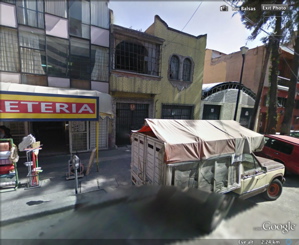
See your neighbourhood in a TV news story, and it seems more real than when you actually walk down your own street. The media are like that: their electronic illusions vindicate physical reality.
When Google Earth came along, I used it to visit places I've lived in or visited, or just felt like seeing. It was fun to plunge out of space into the lower mainland and to hover over Deep Cove before flying across the North Shore and then up the coast to Sointula on Malcolm Island.
The experience wasn't really that good, though. Descend too close, and everything blurred.
Then Google brought in Street View, the result of untold millions spent photographing every urban street in North America right at ground level.
This was different. Instead of a fuzzy view of my own roof as seen from space, I saw my front yard in June 2009, with the apple tree in bloom.
Even so, I didn't revisit many of my old haunts until I heard that Street View was now available for Mexico City. My family had lived there from the fall of 1950 to winter 1954, but I hadn't been there since the summer of 1957. For over half a century I'd remembered every street we lived on -- from the apartment on Lafayette 13 to the house on a dirt road just off Observatorio near the American School, where our mother taught and my brothers and I were pupils.
I'd explored Mexico City on Google Earth before, but it had expanded enormously from a city of three million in the mid-1950s to today's megalopolis of 20 million. I had trouble finding my way around, and all I got for my pains was a view of rooftops and streets.
Rip Van Winkle in Mexico
Now Street View lets me return to the places I'd lived, like Rip Van Winkle stumbling back into his village after his long sleep. Lafayette 13 had been a pleasant apartment building, just around the corner from Calle Shakespeare (sha-kes-pay-A-ray), where a Spanish Republican exile ran a little grocery store. Now the building looks tired and battered. A block away, a park with a big central fountain had been our playground. It's gone, a sacrifice to the gods of Mexican traffic.
Other neighbourhoods have changed even more, sometimes for the better. We'd lived at two different places on Ejercito Nacional (National Army Avenue). Today the road looks more like a freeway. Our house near the American School had been a walled enclave in a reeking slum of cardboard shanties. Now the neighbourhood is chopped up into tidy little streets with well-kept houses.
The biggest shock was to see the house we'd lived in when my parents finally split up in 1952. It's still there, painted a ghastly yellow, and surrounded by shops and businesses instead of other houses. It doesn't even look inhabited.
But I could see the big metal door that opened into the patio, and above it the glassed-in balcony where my father had set up his ham radio: XE1XE, a really cool call sign. His walls had been covered with QSL cards from other hams, eager to record their contact with him in that pre-internet age. We raised a turkey on the roof, and at some point we ate it. I could remember the bedroom in the back of the house where I slept, and where I'd wondered what would happen after my father moved out.
The gentrification of Hell's Kitchen
A lot happens in a few years when you're young. Six years after living in that house, I was in my grandfather's one-room apartment on West 45th Street in Manhattan, just before moving uptown to Columbia University. I remembered a forlorn block of Hell's Kitchen west of 10th Avenue; Google shows me it's now a pleasant, tree-lined urban street.
And before then, my mother, brothers and I had moved back to Los Angeles. My mother got a job teaching in Malibu; we lived in an apartment on Pacific Coast Highway in Santa Monica, where the cost of such a rental is now far beyond the reach of a single mother with three boys.
Our other Los Angeles homes are gone as well. Not long after Pearl Harbor, my parents had bought one of the last homes up for sale in North Hollywood. I remember the pepper trees that grew on Burbank Boulevard, and the searchlights that roamed the night sky during air-raid drills. The dry riverbed where my brother and I played is now a freeway, and the pepper trees gave way to more traffic lanes. The houses are gone, replaced by apartment buildings. The air-raid sirens of the 1950s, intended to warn us of Soviet bombers en route over the pole, are doubtless silent now.
The web has changed our lives in many ways, mostly for the better. We learn more, and learn faster, than we ever imagined we could. But I have learned not to Google the names of old friends: too often I learn they've died, sometimes in terrible ways.
And I have learned not to revisit the streets I grew up on. Better to roam in memory the North Hollywood of the 1940s, and the Mexico City of the 1950s, than to see what they're like today. Even on the street in Deep Cove where I’ve lived since 1972, I've outlived many of trees. I don't need to mourn as well the lost pepper trees of Burbank Boulevard. ![]()
Read more: Science + Tech















Tyee Commenting Guidelines
Comments that violate guidelines risk being deleted, and violations may result in a temporary or permanent user ban. Maintain the spirit of good conversation to stay in the discussion.
*Please note The Tyee is not a forum for spreading misinformation about COVID-19, denying its existence or minimizing its risk to public health.
Do:
Do not: